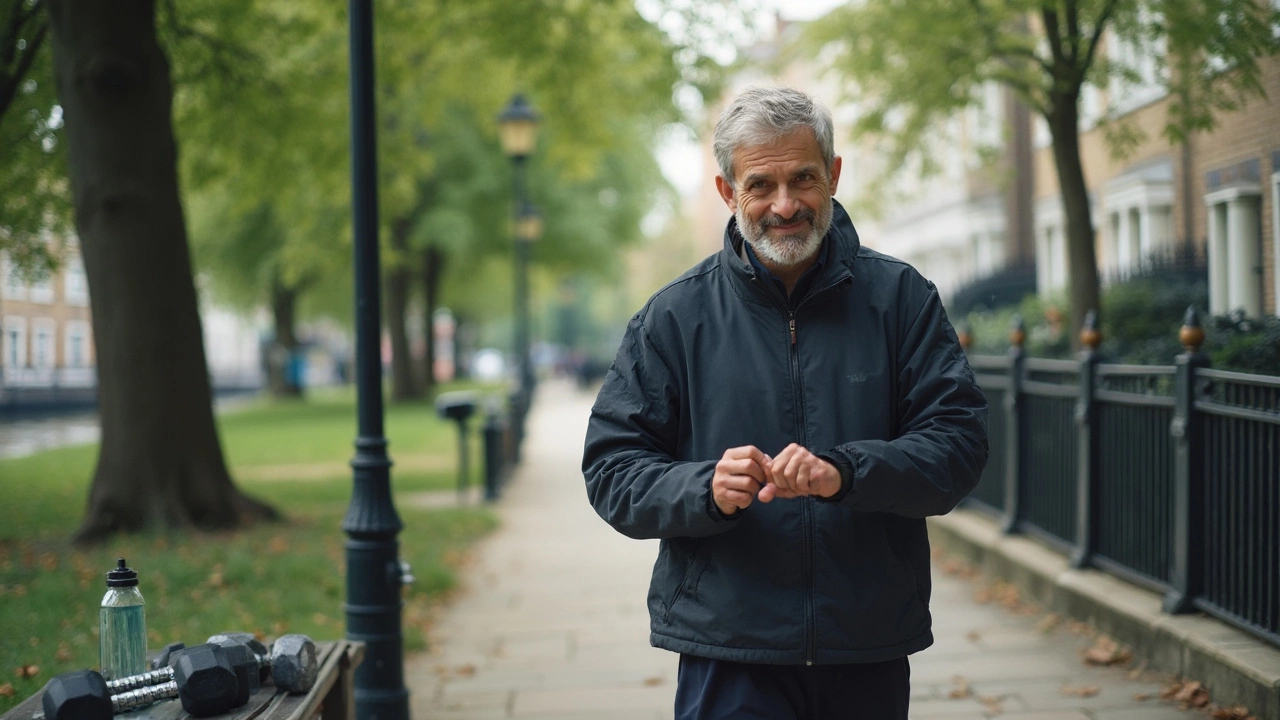
You see people out for walks everywhere—some holding hand weights, others just strolling with their morning coffee. But if you’re hoping walking will flatten your belly, it’s easy to get mixed signals. Can those daily steps really chip away at stubborn fat around your waist?
Here’s the reality: walking does burn calories. That matters, because to drop any fat—including belly fat—you need to burn more than you take in. But it’s not quite as simple as ‘walk more, lose your gut.’ Your body decides where to lose fat first, not you, and that usually means the belly is last to go.
But there’s good news. Walking can still move the needle if you’re consistent. You don’t need to turn into a marathoner either—brisk walking, especially if you build it into your everyday routine, helps create that calorie deficit for fat loss. Simple stuff like picking up the pace, adding hills, or swinging your arms can up the burn. And combining walking with quick strength training makes your walks much more effective.
Walking gets tossed around as an easy fix for losing belly fat, but what does research actually say? Let’s be real: spot-reducing fat from your stomach just by walking isn’t a thing. No workout can turn your body into a fat-melting GPS. Your body pulls fat from all over—not just your gut—when you create a calorie deficit.
That said, walking does help chip away at your total body fat, including what’s around your middle. One 2014 study split middle-aged women into a walking group and a no-exercise group. After 12 weeks, the walkers dropped more body fat around their waists—even though all they did was walk at a brisk pace for 50-70 minutes, three times a week.
Check out what a few real studies have measured when it comes to walking and belly fat:
| Study | Walking Plan | Fat Loss Findings |
|---|---|---|
| 2014 Korean Study (Postmenopausal Women) | Brisk walk (50-70 min, 3x/wk, 12 weeks) | Lost 1.1 inches from waist, significant belly fat drop |
| 2012 Journal of Exercise Nutrition & Biochemistry | Walked 40 min/day, 5 days/week, 12 weeks | Waist size dropped, overall body fat % down |
| 2019 Obesity Review Meta-analysis | Various walking plans, at least 30 min/day | Belly fat trimmed in most overweight adults |
Plain and simple, consistent walking reduces overall body fat, and yes, some belly fat too. But you have to stick with it. You can’t just walk a mile here and there and expect a shredded waist. There’s no magic number, but most experts suggest aiming for at least 150 minutes of moderate walking each week for fat loss. And if you want to get serious about shedding belly fat, bumping that number up even higher pays off.
Walking might feel effortless after a while, but your body is actually clocking in some serious calorie-burning time every step you take. When you walk, your muscles contract to move your legs and swing your arms. That movement needs energy—and your body grabs that energy by burning calories from food or stored fat.
The number of calories you burn from walking depends on three things: your weight, your pace, and how long you go. Here’s a look at some numbers:
| Weight | Walking Speed | Calories Burned (30 minutes) |
|---|---|---|
| 125 lbs | 3 mph | 107 |
| 155 lbs | 3 mph | 133 |
| 185 lbs | 3 mph | 159 |
| 185 lbs | 4 mph (brisk) | 222 |
Walking faster and adding inclines—think hills or even a treadmill set to an incline—makes your body work harder, cranking up the calorie burn. If you really want to see a difference, try to get your heart rate up. If you can’t finish a sentence without catching your breath, you’re in the right zone.
Still, it’s not just about the numbers. Consistency wins the race. A few short walks won’t do much, but regular walks—think 150 minutes a week or more—can actually help with belly fat and your overall health. Plus, walking is easy to work into daily life. Walk during phone calls, take the stairs, park farther from the store, or grab a friend for a lunchtime stroll.
Bottom line: walking isn’t going to torch hundreds of calories in one go, but stack those walks up over a week or month and you might be surprised by how much energy you’ve burned just moving through your day.
You’ve probably heard someone say, “Walk enough, and you’ll lose that belly.” Here’s the catch: you can’t actually pick where your body loses fat. This is called “spot reduction,” and it’s basically a myth. When you lose weight, your body grabs fat from all over, not just your stomach.
Walking burns calories, and if you walk regularly, that helps with overall fat loss. But no matter how many laps you do around the block, your body won’t directly pull fat from your belly just because you want it to. Where you notice fat loss first is up to your genetics and hormones. For some people, belly fat sticks around longer than in other spots.
But don’t get discouraged—walking is still a smart move for trimming down, and studies back it up. For example, a study done in Korea in 2014 tracked women in their 50s who walked briskly for 50 to 70 minutes, three times a week. After 12 weeks, they lost about 1.5 inches from their waists. That’s not overnight magic, but it’s progress.
| Study | Group | Walking Routine | Change in Waist Size |
|---|---|---|---|
| Korea, 2014 | Women, 50s | 50–70 min, 3x/week, 12 weeks | -1.5 inches |
| U.S., 2017 | Men & Women, 20s | 45 min, 5x/week, 6 months | -2.0 inches |
So while you can’t force your body to drop fat exactly where you want, walking—especially brisk walking—still helps lower your overall body fat. If your main goal is to lose belly fat, keep walking, but pair it with eating a bit better and maybe some strength moves. That combo gets you faster results than walking alone.

If you’re serious about getting rid of stubborn around-the-middle fat, you need to focus on doing walking the smart way. Just doing a slow mosey around the block isn’t enough—you need to get your heart rate up and make it a habit.
Start with intensity. You’ll burn more calories, and possibly more fat, by kicking up your walking speed to a brisk pace. You should be able to talk, but not sing. Aim for about 30–60 minutes a day, five days a week. That sounds like a lot, but you can break it up—two 15-minute or three 20-minute walks still count toward your daily routine.
What’s a brisk pace? For most people, it’s about 3–4 miles per hour, or 100–120 steps a minute. Wearing a fitness tracker or even using your phone’s health app can help you keep tabs on your step count and speed. Experts often recommend aiming for at least 7,000–10,000 steps a day if you want to boost fat loss.
Let’s look at some numbers:
| Weight (lbs) | Calories Burned (30-min brisk walk) |
|---|---|
| 125 | 135 |
| 155 | 167 |
| 185 | 200 |
Walking hills or carrying a backpack gives you an extra burn, as does swinging your arms. Changing up your route or mixing in short bursts of faster walking (think intervals) can make things more interesting and raise your heart rate even more.
Now, about the stubborn belly itself—walking alone can help with overall fat loss, but it won’t specifically burn fat just from your belly (no workout can “spot reduce”). Still, studies show that when people combine consistent brisk walking, a calorie-aware diet, and a little strength training, waistlines do get smaller over time.
If you want the biggest impact, don’t just rely on low-intensity strolls. Make your walking intentional and regular, and team it up with basic strength moves like squats or pushups a few times a week. The combo is where you’ll see real change.
You know what most people miss when trying to lose belly fat? They focus only on walking or cardio and skip resistance work. Here's the kicker—adding strength training to your routine can make a huge difference, not just for your arms and legs but for your waistline too.
When you lift weights or do bodyweight exercises like squats and push-ups, your muscles have to recover and rebuild. This process burns more calories, even after your workout is done. So while you might torch calories during a walk, strength training keeps the burn going hours later. That’s what fitness folks call 'afterburn.' Studies from reputable places like Harvard back this up—folks who pair regular strength training with cardio see more fat loss, especially stubborn belly fat.
Here are a few ways to work in some muscle-building without turning your schedule upside down:
If belly fat is your target, don't rely only on walking. Make strength training a regular thing to boost your results and keep the fat loss going. This combo is much more effective than hoping extra steps alone will do the trick. Think of it as doubling down—walking knocks on the door, strength training pushes it open.
And if you’re looking for the biggest impact in your fight against belly fat, strength training deserves a spot on your calendar—right next to those daily walks.
Walking is a solid way to lose weight, but let’s talk numbers and what you’re actually in for if you want to lose belly fat. A lot of apps and trackers say you’ll burn about 100 calories per mile. So, if you’re walking 2 miles a day, that’s around 200 calories—or 1,400 calories over a week. But remember, one pound of fat is roughly equal to 3,500 calories, so you’re looking at a little less than half a pound lost in a week with this amount, as long as you’re not eating more to make up for it.
Here’s a quick breakdown of what different walking routines can add up to, calorie-wise:
| Daily Walking Time | Calories Burned/Week | Fat Loss Potential/Week |
|---|---|---|
| 30 min (moderate pace) | 700-900 | 0.2-0.25 lbs |
| 60 min (brisk pace) | 1,500-1,800 | 0.4-0.5 lbs |
| 90 min (varied pace) | 2,100-2,700 | 0.6-0.75 lbs |
These numbers are averages, since everyone has a different weight, age, and metabolism. If you’re smaller, you’ll burn a bit less; if you’re heavier, the burn is higher.
It’s also smart to be patient with belly fat specifically. Even if the scale goes down, your jeans might not loosen up right away at the waist. Studies have found that, while walking is effective for overall fat loss and boosting energy, spot reducing doesn’t really work. So, you’ll see changes everywhere, not just in your midsection.
If you want to speed things up or make the process more efficient, try combining regular walks with strength training a couple times a week. This helps you hold onto muscle, so most of the weight you lose is actually fat—even from stubborn spots like the belly. Also, dial in your eating habits. No need for wild diets, just keep an eye on portions and swap sugar for more protein and fiber.
Bottom line: It’s absolutely possible to trim down your belly by walking, but expect it to take some time and consistency. If you keep your expectations realistic and mix in a little patience, the results do show up—slowly but surely.